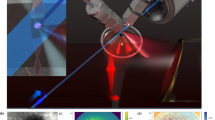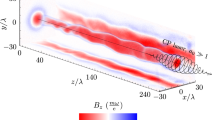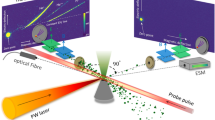Abstract
Collective processes in plasmas often induce microinstabilities that play an important role in many space or laboratory plasma environments. Particularly notable is the Weibel-type current filamentation instability, which is believed to drive the creation of collisionless shocks in weakly magnetized astrophysical plasmas. Here, this instability class is studied through interactions of ultraintense and short laser pulses with solid foils, leading to localized generation of megaelectronvolt electrons. Proton radiographic measurements of both low- and high-resistivity targets show two distinct, superimposed electromagnetic field patterns arising from the interpenetration of the megaelectronvolt electrons and the background plasma. Particle-in-cell simulations and theoretical estimates suggest that the collisionless Weibel instability building up in the dilute expanding plasmas formed at the target surfaces causes the observed azimuthally symmetric electromagnetic filaments. For a sufficiently high resistivity of the target foil, an additional resistive instability is triggered in the bulk target, giving rise to radially elongated filaments. The data reveal the growth of both filamentation instabilities over large temporal (tens of picoseconds) and spatial (hundreds of micrometres) scales.
This is a preview of subscription content, access via your institution
Access options
Access Nature and 54 other Nature Portfolio journals
Get Nature+, our best-value online-access subscription
$29.99 / 30 days
cancel any time
Subscribe to this journal
Receive 12 print issues and online access
$209.00 per year
only $17.42 per issue
Buy this article
- Purchase on Springer Link
- Instant access to full article PDF
Prices may be subject to local taxes which are calculated during checkout




Similar content being viewed by others
Data availability
The data that support the findings of this study are available from the corresponding authors upon reasonable request.
References
Shkarofsky, I., Johnston, T. & Bachynski, M. The Particle Kinetics of Plasmas (Addison-Wesley, 1966).
Belmont, G., Roland, G., Mottez, F., Pantellini, F. & Pelletier, G. Collisionless Plasmas in Astrophysics (Wiley, 2013).
Davidson, R. C. in Handbook of Plasma Physics Vol. 1 (eds Rosenbluth, M. N. & Galeev, R. Z.) 519–585 (North-Holland, 1983).
Weibel, E. S. Spontaneous growing transverse waves in a plasma due to an anisotropic velocity distribution. Phys. Rev. Lett. 2, 83–84 (1959).
Fried, B. D. Mechanism for instability of transverse plasma waves. Phys. Fluids 2, 337–337 (1959).
Davidson, R. C., Hammer, D. A., Haber, I. & Wagner, C. E. Nonlinear development of electromagnetic instabilities in anisotropic plasmas. Phys. Fluids 15, 317–333 (1972).
Lee, R. & Lampe, M. Electromagnetic instabilities, filamentation, and focusing of relativistic electron beams. Phys. Rev. Lett. 31, 1390–1393 (1973).
Adam, J. C., Héron, A. & Laval, G. Dispersion and transport of energetic particles due to the interaction of intense laser pulses with overdense plasmas. Phys. Rev. Lett. 97, 205006 (2006).
Marcowith, A. et al. The microphysics of collisionless shock waves. Rep. Prog. Phys. 79, 046901 (2016).
Schlickeiser, R. & Shukla, P. K. Cosmological magnetic field generation by the Weibel instability. Astrophys. J. Lett. 599, L57–L60 (2003).
Allen, B. et al. Experimental study of current filamentation instability. Phys. Rev. Lett. 109, 185007 (2012).
Fox, W. et al. Filamentation instability of counterstreaming laser-driven plasmas. Phys. Rev. Lett. 111, 225002 (2013).
Huntington, C. M. et al. Observation of magnetic field generation via the Weibel instability in interpenetrating plasma flows. Nat. Phys. 11, 173–176 (2015).
Albertazzi, B. et al. A compact broadband ion beam focusing device based on laser-driven megagauss thermoelectric magnetic fields. Rev. Sci. Instrum. 86, 043502 (2015).
Schoeffler, K. M., Loureiro, N. F., Fonseca, R. A. & Silva, L. O. Magnetic-field generation and amplification in an expanding plasma. Phys. Rev. Lett. 112, 175001 (2014).
Mondal, S. et al. Direct observation of turbulent magnetic fields in hot, dense laser produced plasmas. Proc. Natl Acad. Sci. USA 109, 8011–8015 (2012).
Romagnani, L. et al. Dynamics of the electromagnetic fields induced by fast electron propagation in near-solid-density media. Phys. Rev. Lett. 122, 025001 (2019).
Gremillet, L., Bonnaud, G. & Amiranoff, F. Filamented transport of laser-generated relativistic electrons penetrating a solid target. Phys. Plasmas 9, 941–948 (2002).
Fiore, M., Fiuza, F., Marti, M., Fonseca, R. A. & Silva, L. O. Relativistic effects on the collisionless collisional transition of the filamentation instability in fast ignition. J. Plasma Phys. 76, 813–832 (2010).
Yang, X. H. et al. Effects of filamentation instability on the divergence of relativistic electrons driven by ultraintense laser pulses. Phys. Plasmas 23, 103110 (2016).
Fuchs, J. et al. Spatial uniformity of laser-accelerated ultrahigh-current MeV electron propagation in metals and insulators. Phys. Rev. Lett. 91, 255002 (2003).
MacLellan, D. A. et al. Annular fast electron transport in silicon arising from low-temperature resistivity. Phys. Rev. Lett. 111, 095001 (2013).
Storm, M. et al. High-current, relativistic electron-beam transport in metals and the role of magnetic collimation. Phys. Rev. Lett. 102, 235004 (2009).
Wei, M. S. et al. Observations of the filamentation of high-intensity laser-produced electron beams. Phys. Rev. E 70, 056412 (2004).
Quinn, K. et al. Weibel-induced filamentation during an ultrafast laser-driven plasma expansion. Phys. Rev. Lett. 108, 135001 (2012).
Metzkes, J. et al. Experimental observation of transverse modulations in laser-driven proton beams. New J. Phys. 16, 023008 (2014).
Göde, S. et al. Relativistic electron streaming instabilities modulate proton beams accelerated in laser–plasma interactions. Phys. Rev. Lett. 118, 194801 (2017).
Scott, G. G. et al. Diagnosis of Weibel instability evolution in the rear surface density scale lengths of laser solid interactions via proton acceleration. New J. Phys. 19, 043010 (2017).
Héron, A. & Adam, J. C. Physics of the interaction of ultra intense laser pulses with cold collisional plasma using large scale kinetic simulations. Phys. Plasmas 22, 072306 (2015).
Lefebvre, E. et al. Electron and photon production from relativistic laser–plasma interactions. Nucl. Fusion 43, 629–633 (2003).
Ren, C. et al. A global simulation for laser-driven MeV electrons in 50-μm fast ignition targets. Phys. Plasmas 13, 056308 (2006).
Dieckmann, M. E., Kourakis, I., Borghesi, M. & Rowlands, G. One-dimensional particle simulation of the filamentation instability: electrostatic field driven by the magnetic pressure gradient force. Phys. Plasmas 16, 074502 (2009).
Bret, A., Gremillet, L. & Dieckmann, M. E. Multidimensional electron beam-plasma instabilities in the relativistic regime. Phys. Plasmas 17, 120501 (2010).
Mora, P. Thin-foil expansion into a vacuum. Phys. Rev. E 72, 056401 (2005).
Lee, Y. T. & More, R. M. An electron conductivity model for dense plasmas. Phys. Fluids 27, 1273–1286 (1984).
McKenna, P. et al. Effect of lattice structure on energetic electron transport in solids irradiated by ultraintense laser pulses. Phys. Rev. Lett. 106, 185004 (2011).
Doumy, G. et al. Complete characterization of a plasma mirror for the production of high-contrast ultraintense laser pulses. Phys. Rev. E 69, 026402 (2004).
Sarri, G. et al. Dynamics of self-generated, large amplitude magnetic fields following high-intensity laser matter interaction. Phys. Rev. Lett. 109, 205002 (2012).
Chen, S. N. et al. Absolute dosimetric characterization of Gafchromic EBT3 and HDv2 films using commercial flat-bed scanners and evaluation of the scanner response function variability. Rev. Sci. Instrum. 87, 073301 (2016).
Sokolov, I. V. Alternating-order interpolation in a charge-conserving scheme for particle-in-cell simulations. Comput. Phys. Commun. 184, 320–328 (2013).
Lehe, R., Lifschitz, A., Thaury, C., Malka, V. & Davoine, X. Numerical growth of emittance in simulations of laser-wakefield acceleration. Phys. Rev. Spec. Top. Accel. Beams 16, 021301 (2013).
Vay, J.-L., Geddes, C. G. R., Cormier-Michel, E. & Grote, D. P. Numerical methods for instability mitigation in the modeling of laser wakefield accelerators in a Lorentz-boosted frame. J. Comput. Phys. 230, 5908–5929 (2011).
Friedman, A. A 2nd-order implicit particle mover with adjustable damping. J. Comput. Phys. 90, 292–312 (1990).
Pérez, F., Gremillet, L., Decoster, A., Drouin, M. & Lefebvre, E. Improved modeling of relativistic collisions and collisional ionization in particle-in-cell codes. Phys. Plasmas 19, 083104 (2012).
Cohen, B., Kemp, A. & Divol, L. Simulation of laser plasma interactions and fast-electron transport in inhomogeneous plasma. J. Comput. Phys. 229, 4591–4612 (2010).
Stephens, R. B. et al. Kα fluorescence measurement of relativistic electron transport in the context of fast ignition. Phys. Rev. E 69, 066414 (2004).
Ping, Y. et al. Absorption of short laser pulses on solid targets in the ultrarelativistic regime. Phys. Rev. Lett. 100, 085004 (2008).
Decoster, A., Markowich, P., Perthame, B. & Raviart, P. Modeling of Collisions (Series in Applied Mathematics, Gauthier-Villars, 1998).
Highland, V. L. Some practical remarks on multiple scattering. Nucl. Instrum. Methods 129, 497–499 (1975).
Groom, D. E. & Klein, S. R. Passage of particles through matter. Eur. Phys. J. C 15, 163–173 (2000).
Acknowledgements
We thank F. Amiranoff, F. Fiuza, E. d’Humières, V. Gubchenko and V. T. Tikhonchuk for insightful discussions. We also acknowledge the support of the JLF-Titan technical teams. The simulations were performed using HPC resources at TGCC/CCRT. We acknowledge PRACE for awarding us access to TGCC/Curie (grant 2014112576). This project has received funding from the European Union’s Horizon 2020 research and innovation programme under grant agreement 654148 Laserlab-Europe and from the European Research Council (ERC) under the European Union’s Horizon 2020 research and innovation programme under grant agreement 787539. The research leading to these results is supported by Extreme Light Infrastructure Nuclear Physics (ELI-NP) Phase II, a project cofinanced by the Romanian Government and European Union through the European Regional Development Fund. This work was partly done within the LABEX Plas@Par project. It was supported by grants 11-IDEX-0004-02 and ANR-17-CE30-0026-Pinnacle from Agence Nationale de la Recherche. This work was also partly supported by the DFG GRK 1203 and SFB/TR18 programmes and by EPSRC grants EP/K022415/1 and EP/J002550/1. It was supported in part by the Ministry of Education and Science of the Russian Federation under contract 14.Z50.31.0007. The use of the Jupiter Laser Facility was supported by the US Department of Energy, Lawrence Livermore National Laboratory, under contract DE-AC52-07NA27344.
Author information
Authors and Affiliations
Contributions
J.F. conceived the project. B.A., S.N.C., P.A., J.B., V.D., L.L., M.N., L.R., M. Swantusch, M.B., H.P. and J.F. performed the experiment, with support from R.S., O.W. and M. Starodubtsev. B.A., S.B. and J.F. analysed the data. C. Ruyer and L.G. developed the theoretical framework and performed the simulations, with discussions with M.G. and C. Riconda. S.B. computed the synthetic proton radiographs. J.F., C. Ruyer and L.G. wrote the paper. All authors commented on the paper in its various stages.
Corresponding authors
Ethics declarations
Competing interests
The authors declare no competing interests.
Additional information
Peer review information Nature Physics thanks Francesco Pegoraro, Luis Silva and the other, anonymous, reviewer(s) for their contribution to the peer review of this work.
Publisher’s note Springer Nature remains neutral with regard to jurisdictional claims in published maps and institutional affiliations.
Supplementary information
Supplementary Information
Supplementary Figs. 1–10 and discussion.
Rights and permissions
About this article
Cite this article
Ruyer, C., Bolaños, S., Albertazzi, B. et al. Growth of concomitant laser-driven collisionless and resistive electron filamentation instabilities over large spatiotemporal scales. Nat. Phys. 16, 983–988 (2020). https://doi.org/10.1038/s41567-020-0913-x
Received:
Accepted:
Published:
Issue Date:
DOI: https://doi.org/10.1038/s41567-020-0913-x
This article is cited by
-
Electron Weibel instability and quasi-magnetostatic structures in an expanding collisionless plasma
Reviews of Modern Plasma Physics (2024)
-
Self-organization of photoionized plasmas via kinetic instabilities
Reviews of Modern Plasma Physics (2023)



